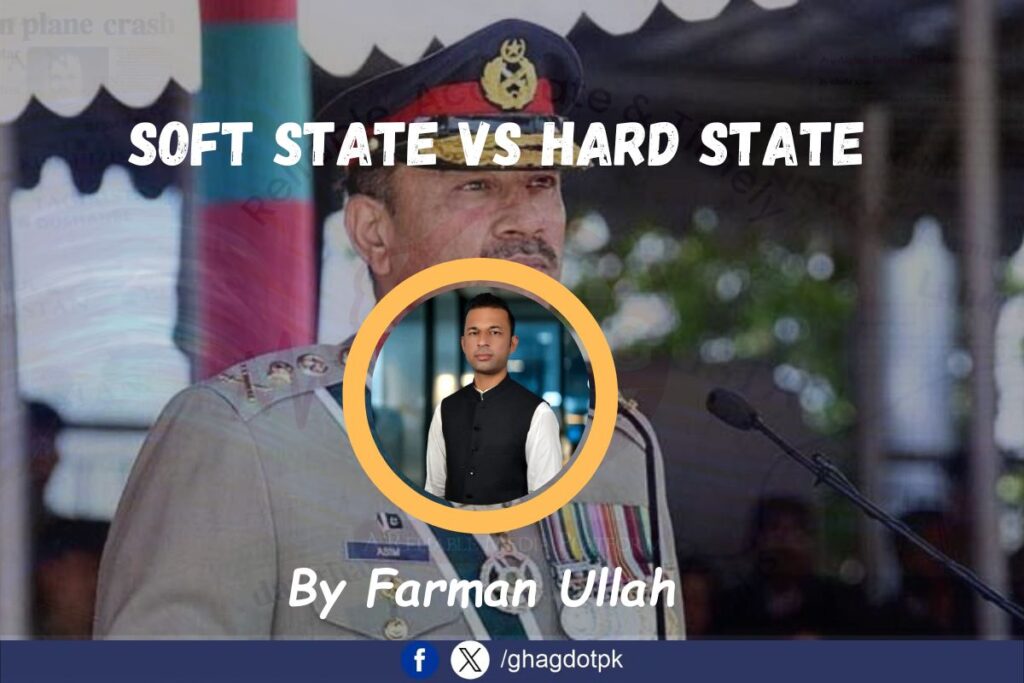By Farman Ullah
The concepts of “hard state” and “soft state” are often used to describe the nature of governance, state authority, and institutional strength. These terms serve to categorize states based on their ability to exercise control, enforce laws, and ensure security. A “hard state” represents a strong, authoritative government with the capacity to maintain law and order through coercive means, such as the military, police, and legal systems. In contrast, a “soft state” reflects a weaker government with limited enforcement power, where lawlessness, corruption, and a lack of institutional strength may prevail. This dichotomy is crucial in understanding the dynamics of governance, especially in a country like Pakistan, where General Asim Munir, the Chief of Army Staff (COAS), has recently addressed issues concerning state stability, sovereignty, and security.
The concept of Hard State
A “hard state” refers to a governmental structure with robust institutions capable of maintaining strict control over its territory, ensuring the rule of law, and protecting its citizens.The state’s authority is absolute, often backed by military or police force, and decision-making is hierarchical. In essence, the hard state is defined by its ability to act decisively and enforce laws without hesitation or external interference.
The Soft State Reality
On the other hand, a “soft state” lacks the power and institutional strength to enforce its laws effectively. In a soft state, governance may be inefficient, and there is often a significant gap between legal norms and actual practices. Corruption, weak institutions, and ineffective law enforcement characterize soft states. This results in a society where the government struggles to maintain order, leading to widespread instability and insecurity. Such states often face challenges in protecting sovereignty and ensuring national security.
The Role of the Military in a Hard State
The military plays a pivotal role in the development and maintenance of a hard state. In many countries, especially those in conflict zones, the military provides the backbone of state authority, stepping in when civilian law enforcement is either unable or unwilling to act. General Asim Munir’s recent speeches have emphasized the importance of military discipline and coordination in safeguarding Pakistan’s sovereignty. His message underscores the critical role of a well-equipped and professional military in transforming a soft state into a more resilient and secure hard state.
General Asim Munir’s Perspective on State Sovereignty
In his recent speeches, COAS Asim Munir has stressed the importance of sovereignty and national security for Pakistan. He has highlighted the need for a “hard state” approach, where institutions are strong, and external and internal threats are managed decisively. Munir’s remarks reflect a concern for Pakistan’s vulnerability to both external aggression and internal instability. His call for a cohesive national security framework indicates a strategic shift towards reinforcing the state’s authority and fortifying its institutions.
Civil-Military Relations and the Soft State Phenomenon
The relationship between the military and the civilian government is often a defining factor in whether a state remains a hard or soft state. In Pakistan, historical tensions between civilian governments and the military have created a complex governance environment. General Asim Munir’s address also touches on the need for greater civil-military coordination, suggesting that a collaborative approach could help strengthen national resilience. This cooperation would enable Pakistan to address both its internal and external challenges more effectively.
The Importance of Hard State Characteristics in National Security
A hard state is essential for national security because it ensures that a country can defend itself from both internal and external threats. General Asim Munir has emphasized the importance of a strong, well-coordinated military force as essential for preserving Pakistan’s borders and maintaining peace. The military’s role in counterterrorism, border security, and disaster response highlights the necessity of having a robust state apparatus that can respond to crises swiftly and decisively.
Economic Stability and the Hard State Model
Economic stability is another key feature of a hard state. For Pakistan, economic growth and stability are inextricably linked to strong governance. General Asim Munir has pointed out that economic challenges often stem from governance weaknesses. A hard state ensures that resources are effectively managed and distributed, thereby fostering economic growth, reducing poverty, and increasing public trust in the government. A soft state, in contrast, may struggle with inefficiency, corruption, and mismanagement, which can exacerbate economic instability.
International Perception of Hard vs. Soft States
Internationally, hard states are often viewed as stable and reliable, which is crucial in the realm of diplomacy and global relations. In his speeches, General Munir has reiterated the importance of a strong national identity and international stature for Pakistan. A hard state earns respect from global powers, especially when it is perceived as capable of handling both internal crises and external threats. In contrast, soft states may find themselves marginalized on the world stage, struggling to secure favorable diplomatic agreements or attract foreign investments.
Challenges of Transitioning from Soft State to Hard State
While the transition from a soft state to a hard state can lead to greater stability, it is not without its challenges. One of the primary obstacles is the resistance from entrenched political elites and societal factions who may perceive the shift as a threat to their power. In Pakistan, this has been particularly challenging, with historical cycles of military coups and civilian rule. However, General Asim Munir’s speeches suggest that a concerted effort to strengthen institutions, enforce laws, and encourage unity could help overcome these hurdles and pave the way for a more resilient state structure.






